HLSC122 ACU Semester 1: Resilience & Burnout Prevention Case Study
VerifiedAdded on 2023/06/11
|25
|11272
|444
Case Study
AI Summary
This case study critically appraises a research paper on the relationship between resilience and burnout among health science students, specifically focusing on whether higher levels of resilience can prevent burnout. The assignment, likely for the HLSC122 course, requires an analysis of the research's authorship, research questions, design, methods, and results, culminating in a conclusion. The scenario involves a student concerned about burnout due to a busy schedule, seeking to understand the benefits of a stress prevention training program. The study used for the appraisal is Harker et al. (2016), which explores resilience and mindfulness as preventative factors for psychological distress, burnout, and secondary traumatic stress among human service professionals.
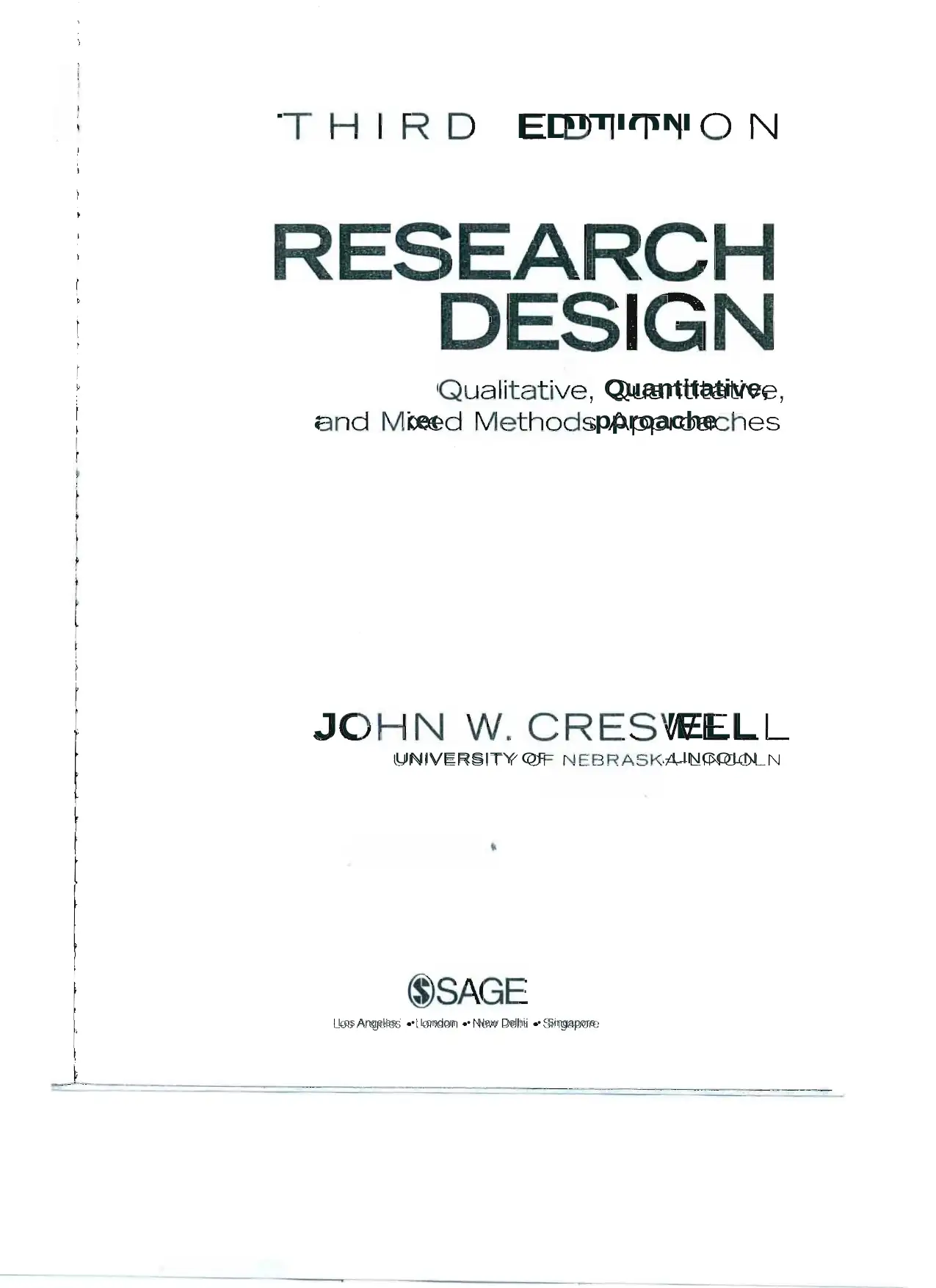
THIRD EDITION
RESEARCH
DESIGN
Qualitative, Quantitative,
and Mixed Methods Approaches
JOHN W. CRESWELL
UNIVERSITY OF NEBRASKA-LlNCOLN
~SAGE
Los Angeles • London • New Delhi • Singapore
RESEARCH
DESIGN
Qualitative, Quantitative,
and Mixed Methods Approaches
JOHN W. CRESWELL
UNIVERSITY OF NEBRASKA-LlNCOLN
~SAGE
Los Angeles • London • New Delhi • Singapore
Paraphrase This Document
Need a fresh take? Get an instant paraphrase of this document with our AI Paraphraser
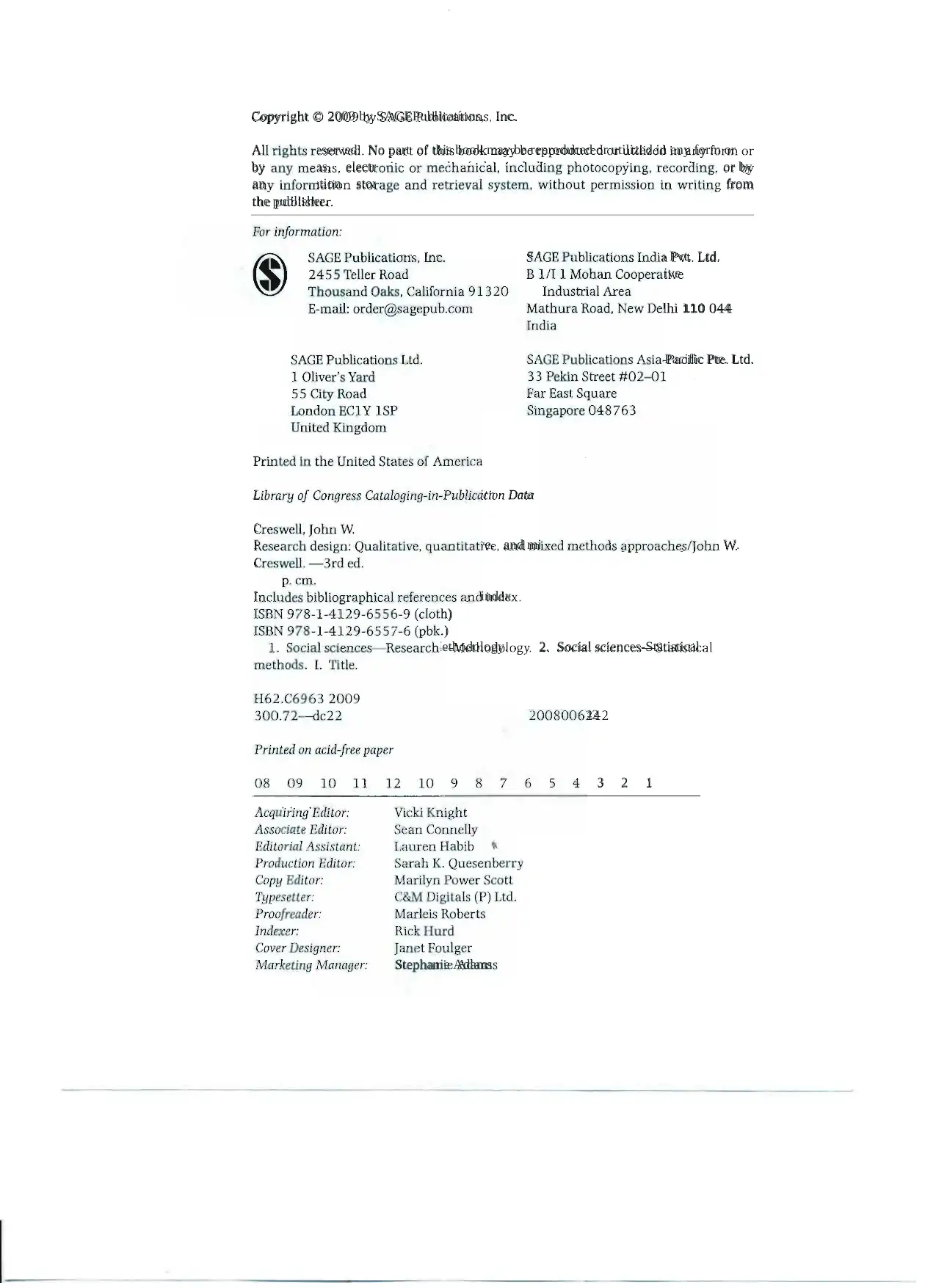
Copyright © 2009 by SAGEPublicatíons, Inc.
Al! rights reserved. No part of this book may be reproduced or utilized in any form or
by any means, electronic or mechanícal, including photocopying. recording. or by
any information storage and retrieval system, without permission in writing from
the publisher.
Por iniormation:
SAGEPublications. Inc.
2455 Tel!er Road
Thousand Oaks, California 91320
E-mail: order@sagepub.com
SAGEPublications India Pvt.
Al! rights reserved. No part of this book may be reproduced or utilized in any form or
by any means, electronic or mechanícal, including photocopying. recording. or by
any information storage and retrieval system, without permission in writing from
the publisher.
Por iniormation:
SAGEPublications. Inc.
2455 Tel!er Road
Thousand Oaks, California 91320
E-mail: order@sagepub.com
SAGEPublications India Pvt.
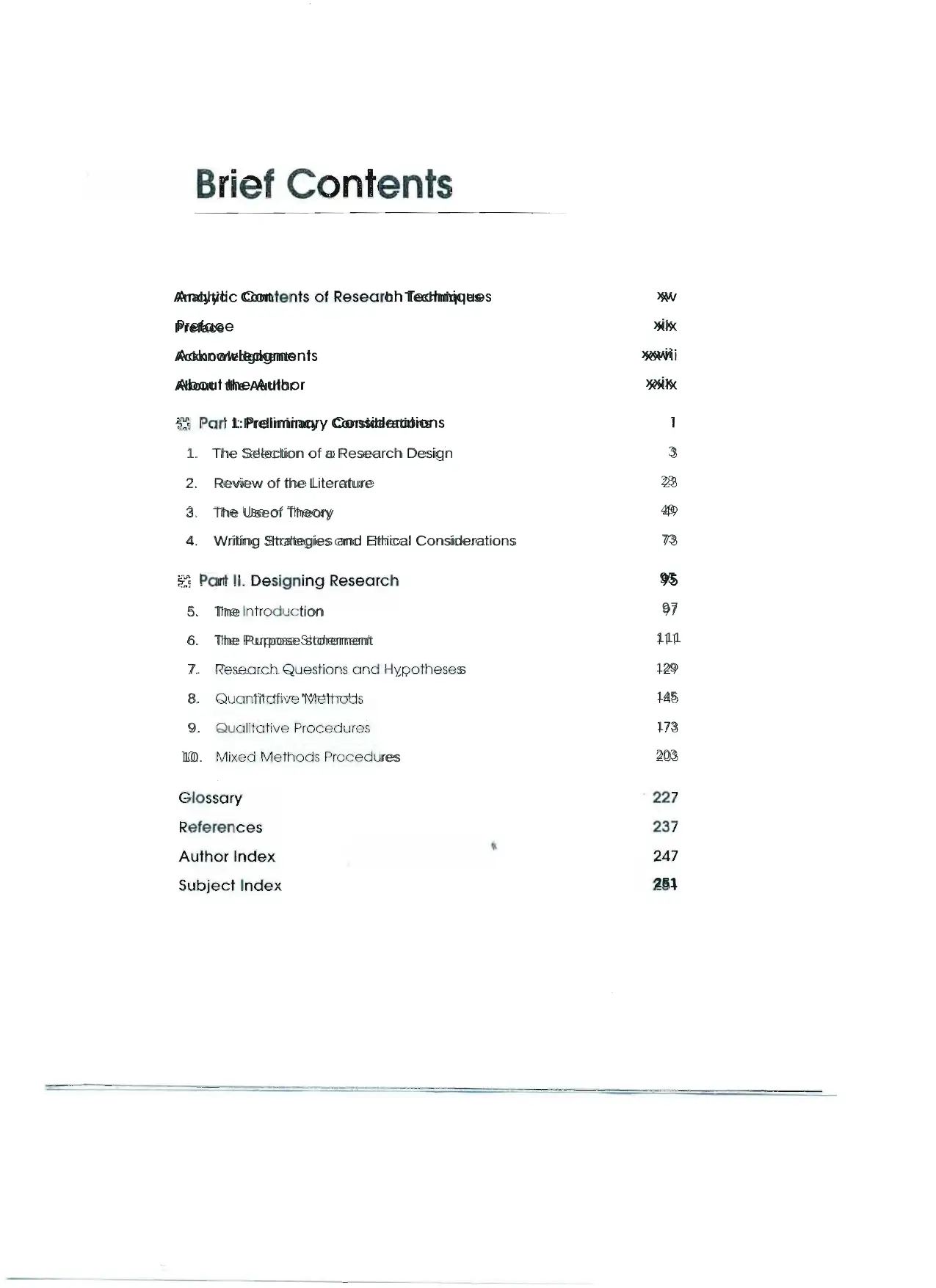
Brief Contents
Analytic Contents of Research Techniques
Preface
Acknowledgments
About the Author
~ Part 1:Preliminary Considerations
1. The Selection of a Research Desiqn
2. Review of the Literature
3. The Useof Theory
4. Writing Strategies and Ethical Considerations
xv
xix
xxvii
xxix
~ Part 11.Designing Research
5. The Introduction
6. The Purpose storernent
7. Research Questions and Hypotheses
8. Quantitative Methods
9. Qualitative Procedures
10. Mixed Methods Procedures
3
23
49
73
95
97
111
129
145
173
203
Glossary
References
Author Index
Subject Index
. 227
237
247
251
Analytic Contents of Research Techniques
Preface
Acknowledgments
About the Author
~ Part 1:Preliminary Considerations
1. The Selection of a Research Desiqn
2. Review of the Literature
3. The Useof Theory
4. Writing Strategies and Ethical Considerations
xv
xix
xxvii
xxix
~ Part 11.Designing Research
5. The Introduction
6. The Purpose storernent
7. Research Questions and Hypotheses
8. Quantitative Methods
9. Qualitative Procedures
10. Mixed Methods Procedures
3
23
49
73
95
97
111
129
145
173
203
Glossary
References
Author Index
Subject Index
. 227
237
247
251
⊘ This is a preview!⊘
Do you want full access?
Subscribe today to unlock all pages.

Trusted by 1+ million students worldwide
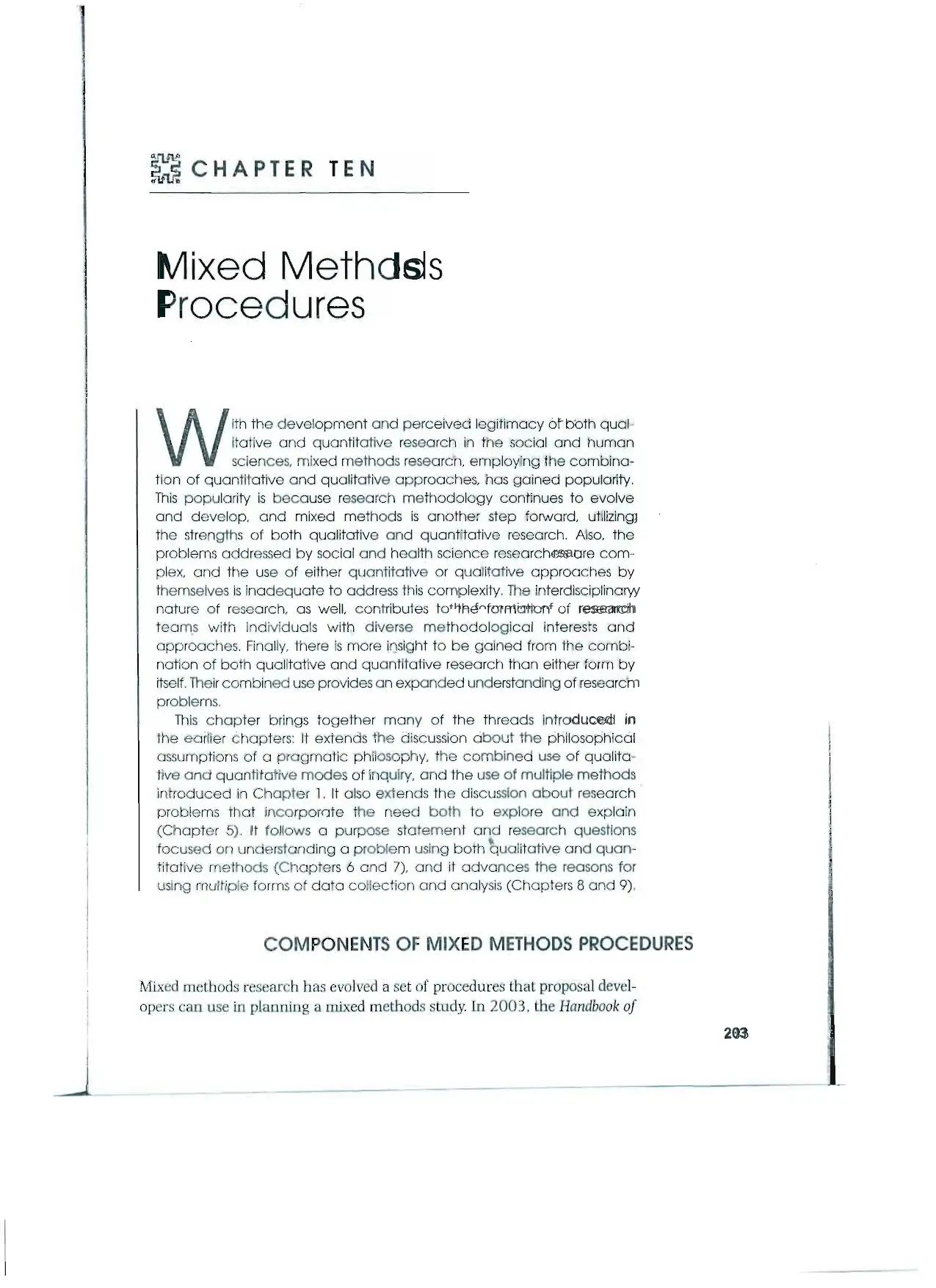
~ CHAPTER TEN
Mixed Methods
Procedures
W ith the development and perceived legitimacy of both qual-
itative and quantitative research in the social and human
sciences, mixed methods research, employing the combina-
tion of quantitative and qualitative approaches, has gained popularity.
This popularity is beca use resear
Mixed Methods
Procedures
W ith the development and perceived legitimacy of both qual-
itative and quantitative research in the social and human
sciences, mixed methods research, employing the combina-
tion of quantitative and qualitative approaches, has gained popularity.
This popularity is beca use resear
Paraphrase This Document
Need a fresh take? Get an instant paraphrase of this document with our AI Paraphraser
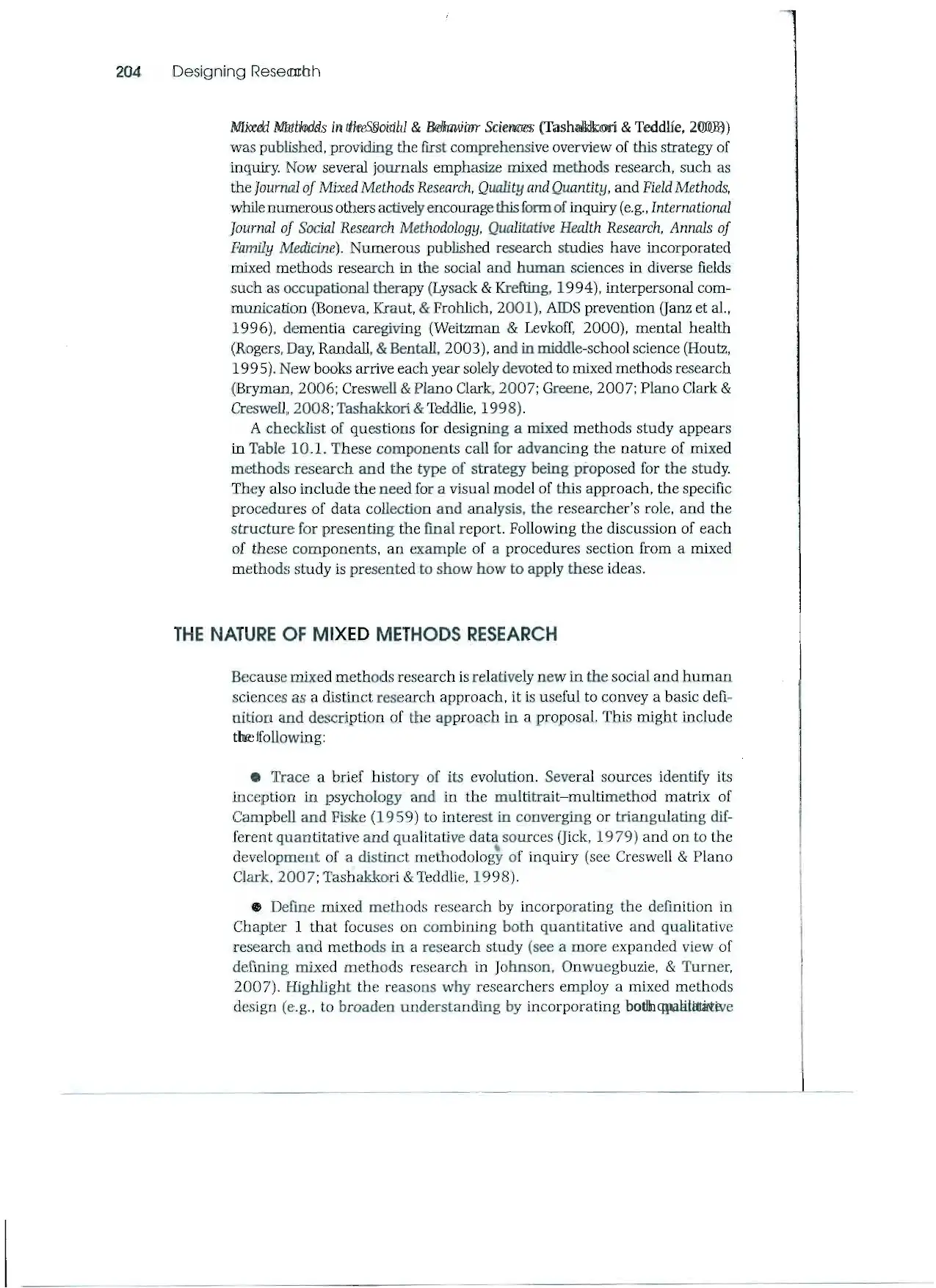
204 Designing Research
Mixed Methods in the Social & Behavior Sciences (Tashakk:ori & Teddlíe, 2003)
was publíshed, providing the fírst comprehensive overview of this strategy of
inquiry. Now several journals emphasize mixed methods research. such as
the Joumal 01 Mixed Methods Beseardi; Quality and Quantity. and Field Methods.
while numerous others activelyencourage this form of inquiry (e.g.. Iniemaiional
[ournal 01 Social Research Methodology. Qualitative Health Research. Annals 01
Family Medicine). Numerous published research studies have incorporated
mixed methods research in the social and human sciences in diverse fields
such as occupational therapy (Lysack & Kreftíng, 1994). interpersonal com-
munication (Boneva, Kraut, & Frohlích, 2001). AIDS prevention (Ianz et al ..
1996), dementia caregiving (Weitzman & Levkoff. 2000). mental health
(Rogers, Day. Randall. & Bentall, 2003). and in míddle-school science (Houtz,
1995). New books arrive each year solely devoted to mixed methods research
(Bryman, 2006; Creswell & Plano Clark, 2007; Greene, 2007; Plano Clark
Mixed Methods in the Social & Behavior Sciences (Tashakk:ori & Teddlíe, 2003)
was publíshed, providing the fírst comprehensive overview of this strategy of
inquiry. Now several journals emphasize mixed methods research. such as
the Joumal 01 Mixed Methods Beseardi; Quality and Quantity. and Field Methods.
while numerous others activelyencourage this form of inquiry (e.g.. Iniemaiional
[ournal 01 Social Research Methodology. Qualitative Health Research. Annals 01
Family Medicine). Numerous published research studies have incorporated
mixed methods research in the social and human sciences in diverse fields
such as occupational therapy (Lysack & Kreftíng, 1994). interpersonal com-
munication (Boneva, Kraut, & Frohlích, 2001). AIDS prevention (Ianz et al ..
1996), dementia caregiving (Weitzman & Levkoff. 2000). mental health
(Rogers, Day. Randall. & Bentall, 2003). and in míddle-school science (Houtz,
1995). New books arrive each year solely devoted to mixed methods research
(Bryman, 2006; Creswell & Plano Clark, 2007; Greene, 2007; Plano Clark
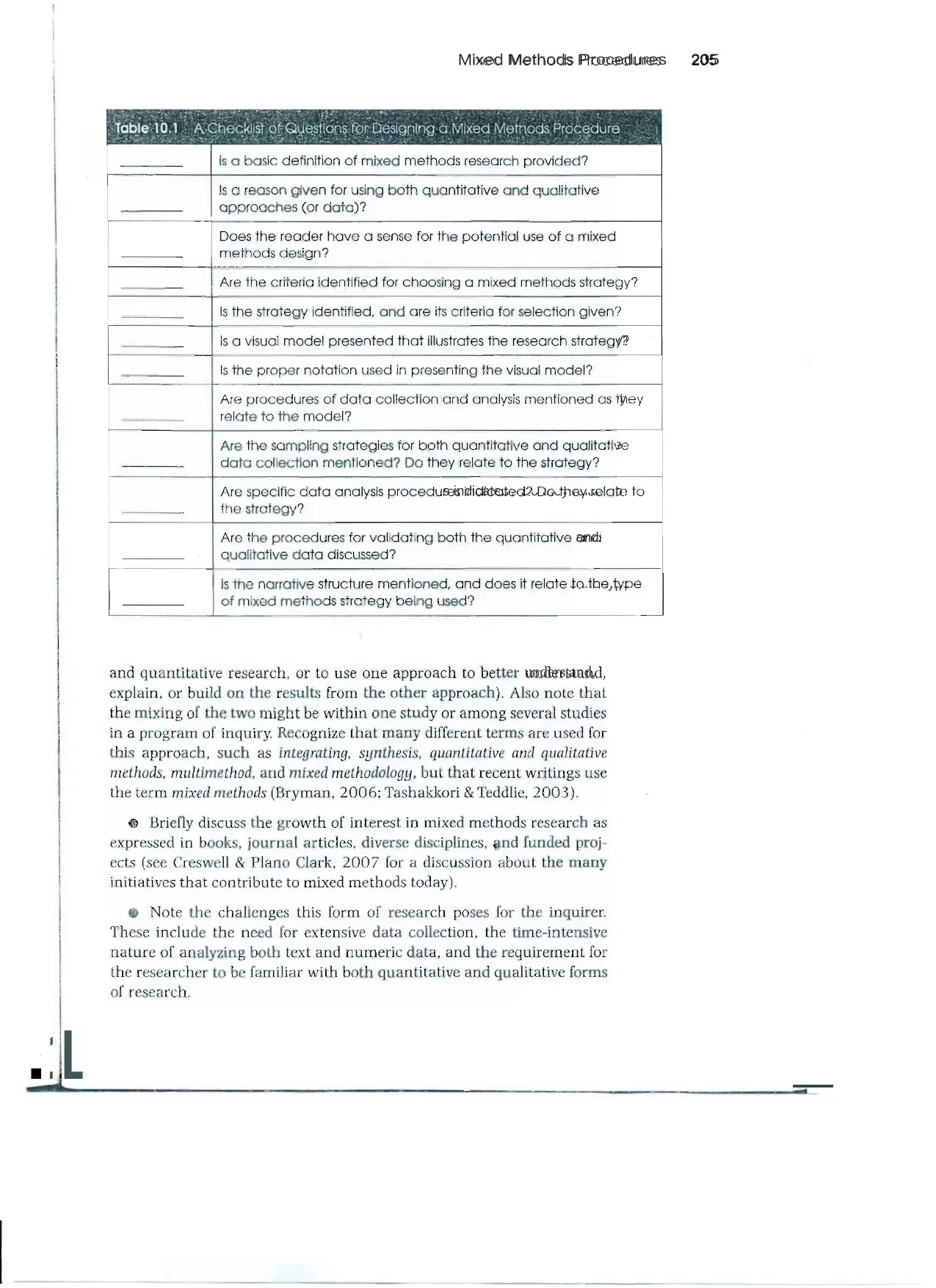
Mixed Methods Procedures 205
;..i{::;r; : ~\-:/f-:'".:i~{='~ ~}!'!_..-1~"i;'" -::~.;f,\~..l'/." ' 'Jl~" ,',;' ~.:."1-•• <; r : .t:> ,; ..-:;,1 '". :-':.~, ": ~. -', .
.::'fáble; 10.1 - -
;..i{::;r; : ~\-:/f-:'".:i~{='~ ~}!'!_..-1~"i;'" -::~.;f,\~..l'/." ' 'Jl~" ,',;' ~.:."1-•• <; r : .t:> ,; ..-:;,1 '". :-':.~, ": ~. -', .
.::'fáble; 10.1 - -
⊘ This is a preview!⊘
Do you want full access?
Subscribe today to unlock all pages.

Trusted by 1+ million students worldwide
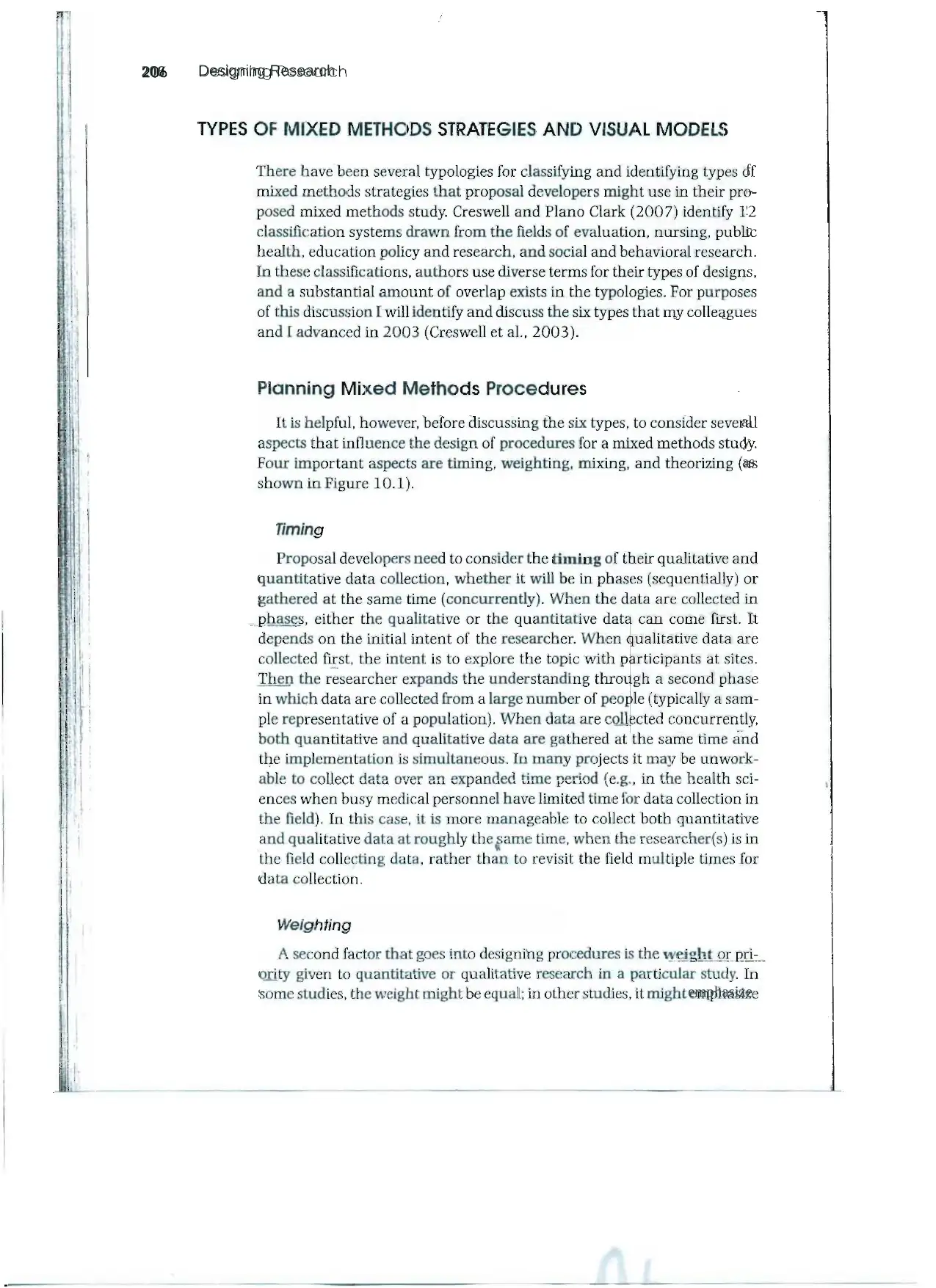
".!
. j
J,.
d'
i,
~f.
\,
I
1:,
206 Designing Research
TYPES OF MIXEO METHOOS STRATEGIESANO VISUAL MOOElS
There have been several typologies for classifying and identifying types of
rnixed methods strategies that proposal developers might use in their pro-
posed mixed methods study. Creswell and Plano Clark (2007) identify 12
classification
. j
J,.
d'
i,
~f.
\,
I
1:,
206 Designing Research
TYPES OF MIXEO METHOOS STRATEGIESANO VISUAL MOOElS
There have been several typologies for classifying and identifying types of
rnixed methods strategies that proposal developers might use in their pro-
posed mixed methods study. Creswell and Plano Clark (2007) identify 12
classification
Paraphrase This Document
Need a fresh take? Get an instant paraphrase of this document with our AI Paraphraser
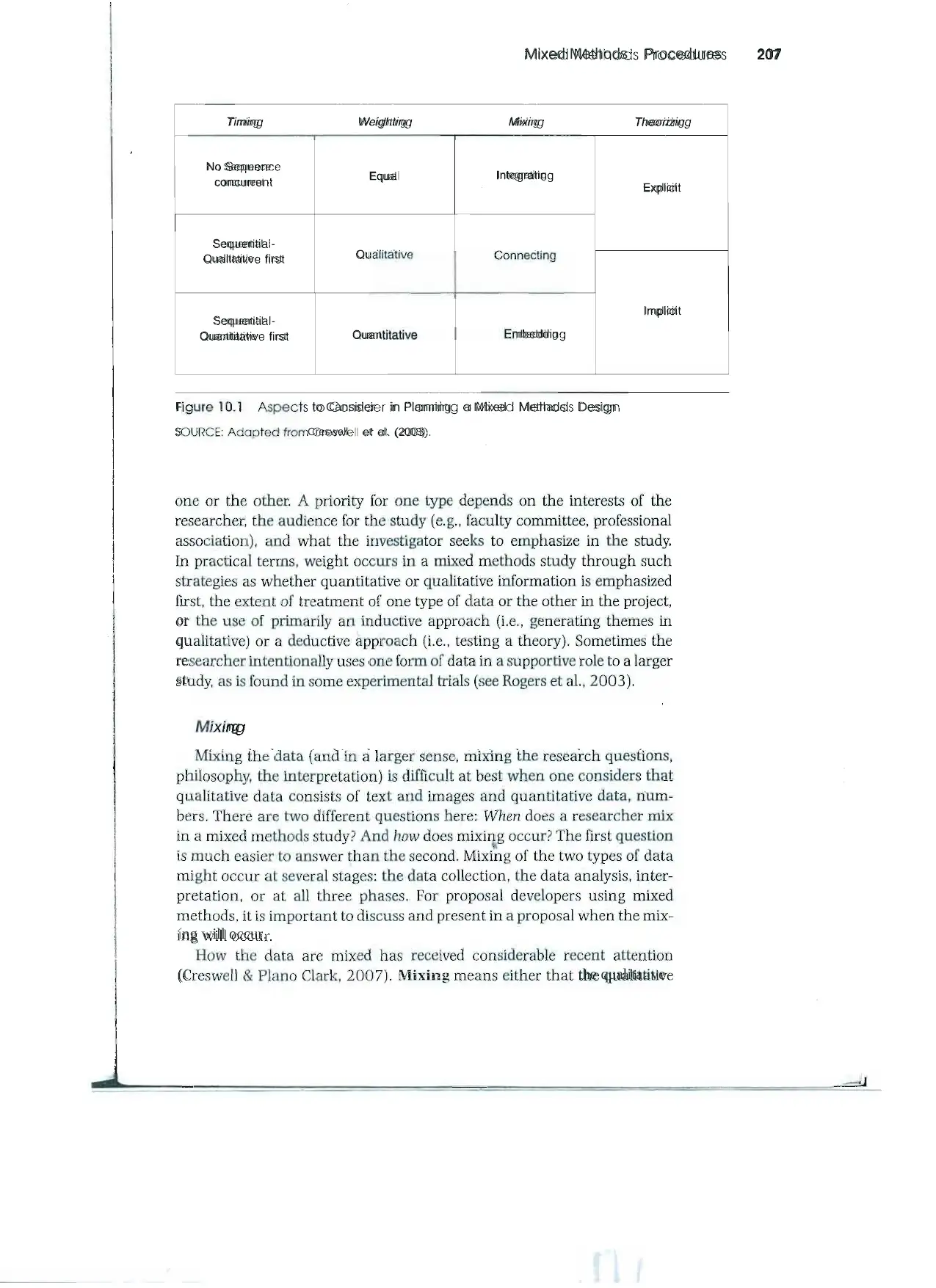
Mixed Methods Procedures 207
Timing Weighting Mixing Theorizing
No Sequence Equal Integrating
concurrent Explicit
Sequential-
Oualitative first Oualitative Connecting
Sequential- Implicit
Ouantitative first Ouantitative Embedding
Figure 10.1 Aspects to Cansider in Planning a Mixed Methads Design
SOURCE: Adapted from Creswell et al. (2003).
one or the other. A priority for one type depends on the interests of the
researcher, the audience for the study (e.g., faculty commíttee, professional
assocíatíon), and what the investigator seeks to emphasize in the study.
In practical terms, weight occurs in a rnixed methods study through such
strategies as whether quantitative or qualitative information ís emphasized
fírst. the extent of treatment of one type of data or the other in the project,
or the use of primarily an inductive approach (i.e., generating themes in
qualitative) or a deductive approach (i.e., testing a theory). Sometímes the
researcher intentionally uses one form of data in a supportive role to a larger
study, as ís found in some experimental trials (see Rogers et al., 2003).
Mixing
Mixing the data (and in a larger sense, mixing the research questíons,
phílosophy, the interpretation) is difficult at best when one considers that
qualitative data consists of text and images and quantitative data, num-
bers. There are two different questions here: When does a researcher rnix
in a mixed methods study? And how does mixing occur? The first question
" .
is much easier to answer than the second. Mixing of the two types of data
míght occur at several stages: the data collectíon, the data analysís, in ter-
pretatíon, or at all three phases. Por proposal developers using mixed
methods, it is important to discuss and present in a proposal when the mix-
íng will occur.
How the data are mixed has received considerable recent attention
(Creswell & Plano Clark, 2007). Mixing means eíther that the qualitative
Timing Weighting Mixing Theorizing
No Sequence Equal Integrating
concurrent Explicit
Sequential-
Oualitative first Oualitative Connecting
Sequential- Implicit
Ouantitative first Ouantitative Embedding
Figure 10.1 Aspects to Cansider in Planning a Mixed Methads Design
SOURCE: Adapted from Creswell et al. (2003).
one or the other. A priority for one type depends on the interests of the
researcher, the audience for the study (e.g., faculty commíttee, professional
assocíatíon), and what the investigator seeks to emphasize in the study.
In practical terms, weight occurs in a rnixed methods study through such
strategies as whether quantitative or qualitative information ís emphasized
fírst. the extent of treatment of one type of data or the other in the project,
or the use of primarily an inductive approach (i.e., generating themes in
qualitative) or a deductive approach (i.e., testing a theory). Sometímes the
researcher intentionally uses one form of data in a supportive role to a larger
study, as ís found in some experimental trials (see Rogers et al., 2003).
Mixing
Mixing the data (and in a larger sense, mixing the research questíons,
phílosophy, the interpretation) is difficult at best when one considers that
qualitative data consists of text and images and quantitative data, num-
bers. There are two different questions here: When does a researcher rnix
in a mixed methods study? And how does mixing occur? The first question
" .
is much easier to answer than the second. Mixing of the two types of data
míght occur at several stages: the data collectíon, the data analysís, in ter-
pretatíon, or at all three phases. Por proposal developers using mixed
methods, it is important to discuss and present in a proposal when the mix-
íng will occur.
How the data are mixed has received considerable recent attention
(Creswell & Plano Clark, 2007). Mixing means eíther that the qualitative
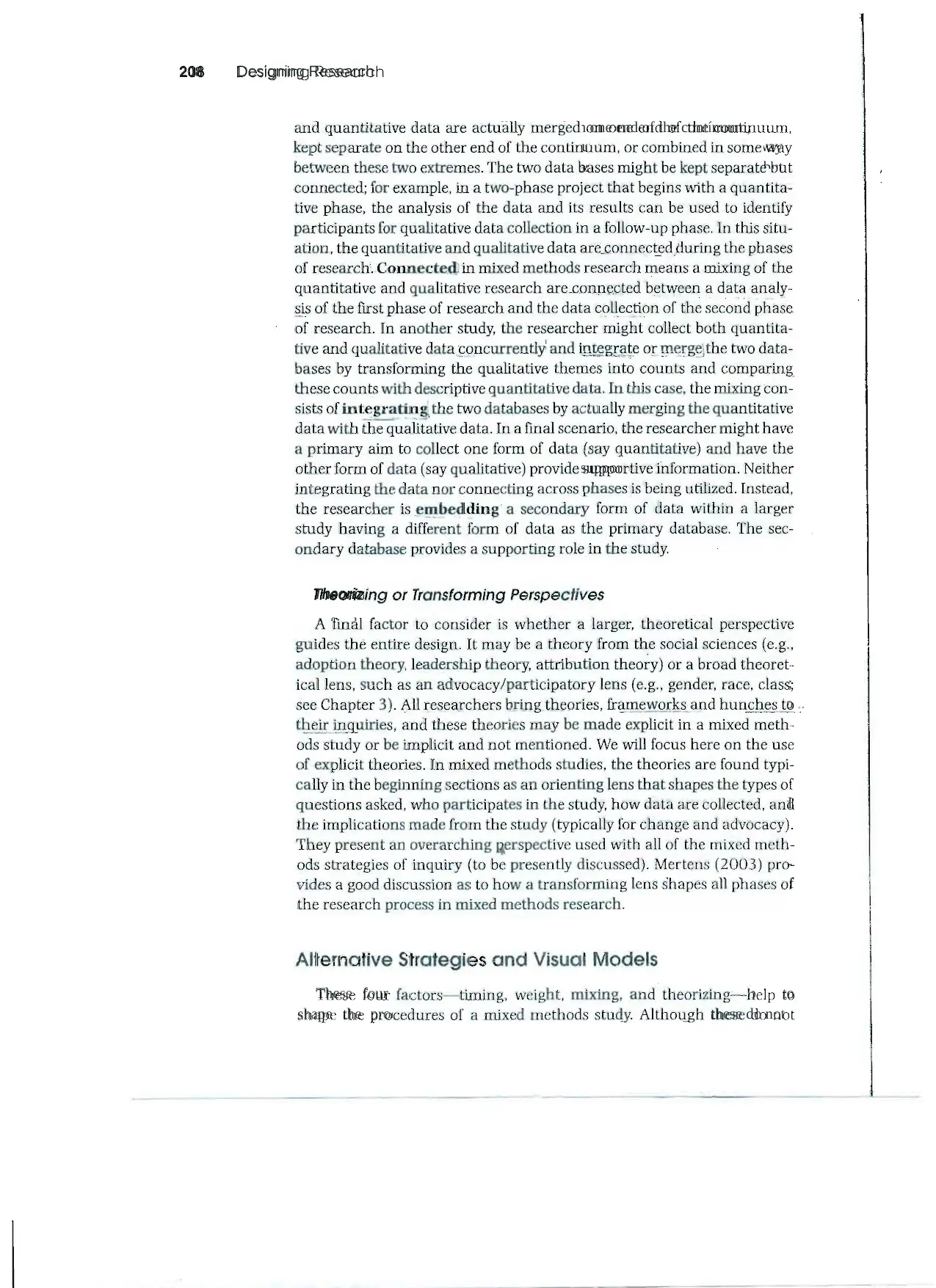
208 Designing Research
and quantitative data are actually merged on one end of the contínuum,
kept separate on the other end of the continuum, or combined in some way
between these two extremes. The two data bases might be kept separate but
connected; for example, in a two-phase project that begins with a quantita-
tive phase, the analysis of the data and its results can be used to identify
participants for qualitative data collection in a follow-up phase. In this sítu-
atíon, the quantitative and qualitative data areconnectedjluring the phases
of research.Connectedl in mixed methods research means a mixing of the
quantitative and qualitative research are.connected between a data .analy-
gs of the fírst phase of research and the data c<?l!ec~~nof the second phase
of research. In another study, the researcher might collect both quantíta-
tive and qualitative dataconcurrently' and 4:!t~g!:i!t~o!;'!ile.xgt::\thetwo data-
bases by transforming the qualitative themes into counts and comparíng
these counts with descriptive quantitative data. In this case, the mixing con-
sists of íntegratíng the two databases by actually merging the quantitative
data with th~ qiI~tative data. In a final scenarío, the researcher might have
a primary aim to coIlect one form of data (say quantitative) and have the
other form of data (say quaIitative) provide supportiveinformation. Neither
integrating the data nor connecting across phases is being utilized. Instead,
the researcher ísembedding a secondary form of data within a larger
study having a different form of data as the primary database. The sec-
ondary database provídes a supporting role in the study.
Theorizing or Transforming Perspectives
A final factor to consider is whether a larger, theoreticaI perspective
guides the entire designo It may be a theory from t~e social sciences (e.g.,
adoption theory,leadership theory, attribution theory) or a broad theoret-
ícal lens, such as an advocacy/participatory lens (e.g., gender, race, class;
see Chapter 3 ).i\.Il researchers bríngtheoríes, frªmewQrks_éip.dhunches to ..
theirJp._<iuiries, and these theories may be made explicit in a mixed meth-
ods study or be implicit and not mentioned. We wiIl focus here on the use
of explicit theories. In mixed methods studíes. the theories are found typí-
cally in the beginning sections as an orienting lens that shapes the types of
questions asked, who participates in the study, how data are collected, and
the implications made from the study (typicaIly for change and advocacy).
They present an overarching Q¡erspectiveused with aIl of the mixed meth-
ods strategies of inquiry (to be presently discussed). Mertens (2003) pro-
vides a good discussion as to how a transforming lens shapes all phases of
the research process in mixed methods research.
Alternative Strategies and Visual Models
These four factors-timing. weíght, míxíng, and theorizing-help to
shape the procedures of a mixed methods study. Although these do not
and quantitative data are actually merged on one end of the contínuum,
kept separate on the other end of the continuum, or combined in some way
between these two extremes. The two data bases might be kept separate but
connected; for example, in a two-phase project that begins with a quantita-
tive phase, the analysis of the data and its results can be used to identify
participants for qualitative data collection in a follow-up phase. In this sítu-
atíon, the quantitative and qualitative data areconnectedjluring the phases
of research.Connectedl in mixed methods research means a mixing of the
quantitative and qualitative research are.connected between a data .analy-
gs of the fírst phase of research and the data c<?l!ec~~nof the second phase
of research. In another study, the researcher might collect both quantíta-
tive and qualitative dataconcurrently' and 4:!t~g!:i!t~o!;'!ile.xgt::\thetwo data-
bases by transforming the qualitative themes into counts and comparíng
these counts with descriptive quantitative data. In this case, the mixing con-
sists of íntegratíng the two databases by actually merging the quantitative
data with th~ qiI~tative data. In a final scenarío, the researcher might have
a primary aim to coIlect one form of data (say quantitative) and have the
other form of data (say quaIitative) provide supportiveinformation. Neither
integrating the data nor connecting across phases is being utilized. Instead,
the researcher ísembedding a secondary form of data within a larger
study having a different form of data as the primary database. The sec-
ondary database provídes a supporting role in the study.
Theorizing or Transforming Perspectives
A final factor to consider is whether a larger, theoreticaI perspective
guides the entire designo It may be a theory from t~e social sciences (e.g.,
adoption theory,leadership theory, attribution theory) or a broad theoret-
ícal lens, such as an advocacy/participatory lens (e.g., gender, race, class;
see Chapter 3 ).i\.Il researchers bríngtheoríes, frªmewQrks_éip.dhunches to ..
theirJp._<iuiries, and these theories may be made explicit in a mixed meth-
ods study or be implicit and not mentioned. We wiIl focus here on the use
of explicit theories. In mixed methods studíes. the theories are found typí-
cally in the beginning sections as an orienting lens that shapes the types of
questions asked, who participates in the study, how data are collected, and
the implications made from the study (typicaIly for change and advocacy).
They present an overarching Q¡erspectiveused with aIl of the mixed meth-
ods strategies of inquiry (to be presently discussed). Mertens (2003) pro-
vides a good discussion as to how a transforming lens shapes all phases of
the research process in mixed methods research.
Alternative Strategies and Visual Models
These four factors-timing. weíght, míxíng, and theorizing-help to
shape the procedures of a mixed methods study. Although these do not
⊘ This is a preview!⊘
Do you want full access?
Subscribe today to unlock all pages.

Trusted by 1+ million students worldwide
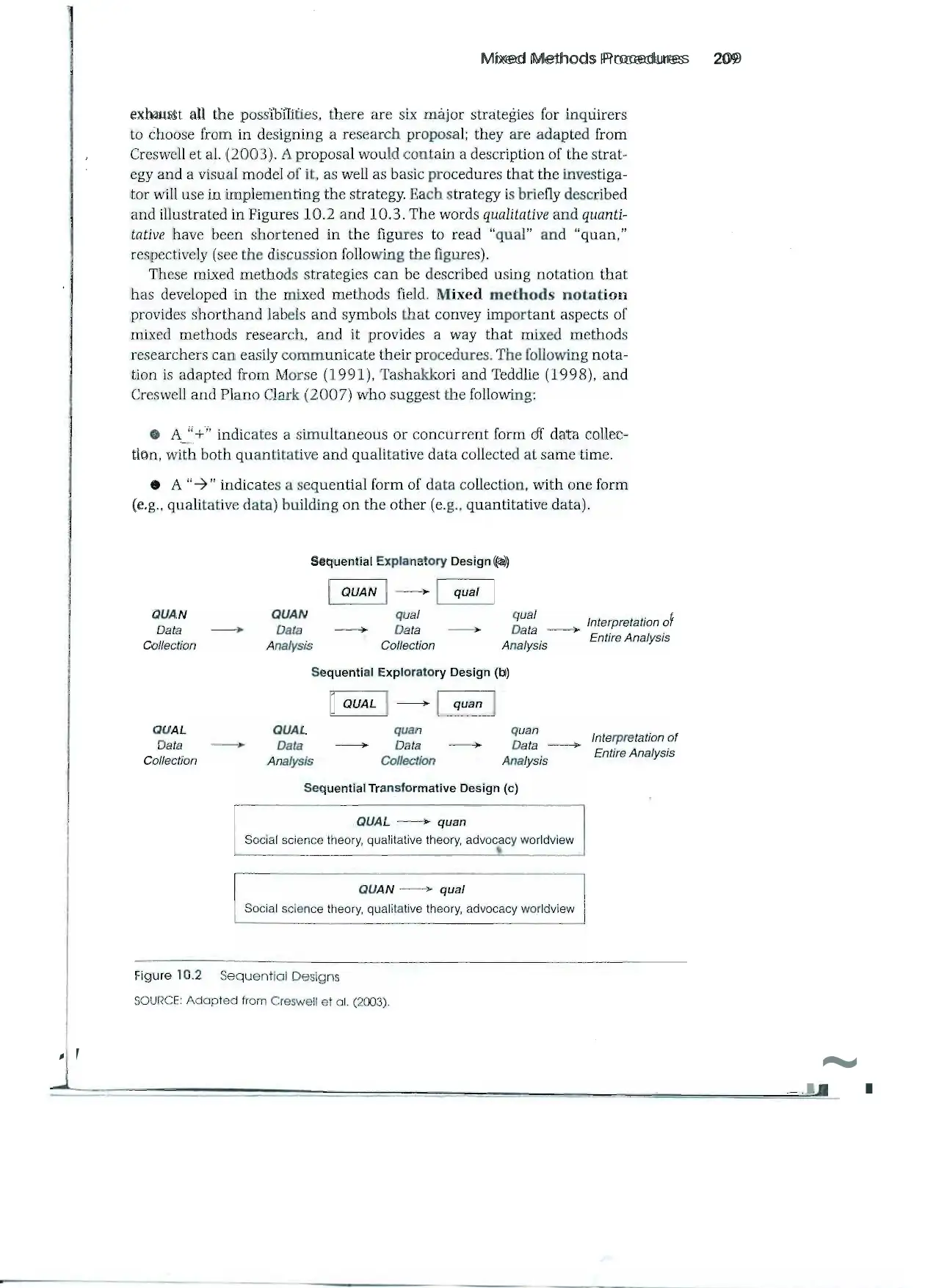
1
Mixed Methods Procedures 209
exhaust all the possibilities, there are six major strategies for inquirers
to choose from in designing a research proposal; they are adapted from
Creswell et al. (2003). A proposal would contain a description of the strat-
egy and a visual model of it, as well as basic procedures that the investiga-
tor will use in implementing the strategy. Each strategy is briefly described
and illustrated in Figures 10.2 and 10.3. The words qualitative and quanii-
tative have been shortened in the figures to read "qual" and "quan,"
respectively (see the discussion following the figures).
These mixed methods strategies can be described using notation that
has developed in the mixed methods field. Mixed methods notation
provides shorthand labels and symbols that convey important aspects of
mixed methods research, and it provides a way that mixed methods
researchers can easily communicate their procedures. The following nota-
tion is adapted from Morse (1991), Tashakkorí and Teddlie (1998), and
CresweH and Plano Clark (2007) who suggest the foHowing:
4) A "+" indicates a simultaneous or concurrent form of data collec-
tion, with both quantitative and qualitative data. collected at same time.
• A" -7" indicates a sequentiaI form of data collectíon, with one form
(e.g., qualitative data) building on the other (e.g., quantitative data).
Sequential Explanatory Design (a)
1 QUAN 1--1 qua!
QUAN QUAN qua! qua! I . f
Data -- Data -- Data -- O t ntetptetetion o
aa -- E . Anelvsi
Collection Analysis Collection Al. ntire na ysts
naysls
Sequential Exploratory Design (b)
QUAL
Data --
Collection
1QUAL 1--1 quan
QUAL quan quan Interpretation of
Data -- Data -- Data --Analysis Collection Analysis Entire Analysis
Sequential Transformative Design (e)
QUAL -- quan
Social science theory, qualitative theory, advocacy worldview
,. .
QUAN --> qual
Social science theory, qualitative theory, advocacy worldview
Figure 10.2 Sequential Designs
SOURCE: Adapted from Creswell et al. (2003).
.~.
Mixed Methods Procedures 209
exhaust all the possibilities, there are six major strategies for inquirers
to choose from in designing a research proposal; they are adapted from
Creswell et al. (2003). A proposal would contain a description of the strat-
egy and a visual model of it, as well as basic procedures that the investiga-
tor will use in implementing the strategy. Each strategy is briefly described
and illustrated in Figures 10.2 and 10.3. The words qualitative and quanii-
tative have been shortened in the figures to read "qual" and "quan,"
respectively (see the discussion following the figures).
These mixed methods strategies can be described using notation that
has developed in the mixed methods field. Mixed methods notation
provides shorthand labels and symbols that convey important aspects of
mixed methods research, and it provides a way that mixed methods
researchers can easily communicate their procedures. The following nota-
tion is adapted from Morse (1991), Tashakkorí and Teddlie (1998), and
CresweH and Plano Clark (2007) who suggest the foHowing:
4) A "+" indicates a simultaneous or concurrent form of data collec-
tion, with both quantitative and qualitative data. collected at same time.
• A" -7" indicates a sequentiaI form of data collectíon, with one form
(e.g., qualitative data) building on the other (e.g., quantitative data).
Sequential Explanatory Design (a)
1 QUAN 1--1 qua!
QUAN QUAN qua! qua! I . f
Data -- Data -- Data -- O t ntetptetetion o
aa -- E . Anelvsi
Collection Analysis Collection Al. ntire na ysts
naysls
Sequential Exploratory Design (b)
QUAL
Data --
Collection
1QUAL 1--1 quan
QUAL quan quan Interpretation of
Data -- Data -- Data --Analysis Collection Analysis Entire Analysis
Sequential Transformative Design (e)
QUAL -- quan
Social science theory, qualitative theory, advocacy worldview
,. .
QUAN --> qual
Social science theory, qualitative theory, advocacy worldview
Figure 10.2 Sequential Designs
SOURCE: Adapted from Creswell et al. (2003).
.~.
Paraphrase This Document
Need a fresh take? Get an instant paraphrase of this document with our AI Paraphraser
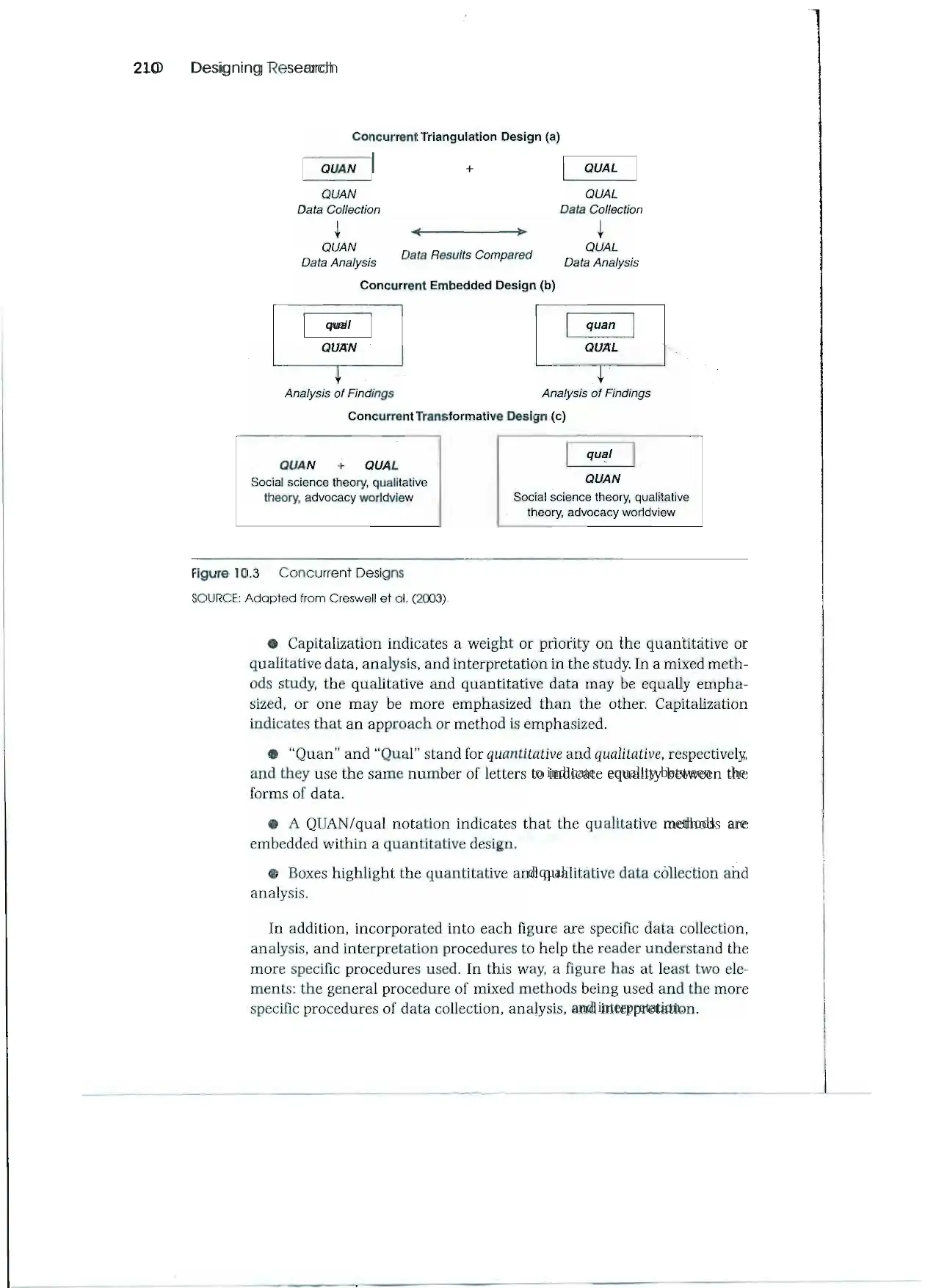
21O Designing Research
ConeurrentTriangulation Design (a)
QUAN I
QUAN
Data Col/ection
+ QUAL
QUAL
Data Col/ection
~
QUAN
Data Analysis
~
QUAL
Data Analysis
Data Results Compared
Coneurrent Embedded Design (b)
qual quan
QUAN QUAL
Analysis ot Findings Analysis ot Findings
Coneurrent Transformative Design (e)
QUAN + QUAL
Social science theory, qualitative
theory, advocacy worldview
QUAN
Social science theory, qualitative
theory, advocacy worldview
Figure 10.3 Concurrent Designs
SOURCE: Adapted from Creswell et al. (2003).
• Capítalization indicates a weight or priority on the quantitative or
qualitative data, analysis, and interpretation in the study. In a mixed meth-
ods study, the qualitative and quantitative data may be equally empha-
sized, or one may be more emphasized than the other. Capitalization
indicates that an approach or method is emphasized.
• "Quan" and "Qual" stand for quaniiiaiive and qualitative, respectively,
and they use the same number of letters to indicate equality between the
forms of data.
• A QUAN/qual notation indicates that the qualitative methods are
embedded within a quantitative designo
e Boxes highlight the quantitative and qualitative data collection and
analysis.
In addition, incorporated into each figure are specific data collection,
analysis, and interpretation procedures to help the reader understand the
more specific procedures used. In this way, a figure has at least two ele-
ments: the general procedure of mixed methods being used and the more
specific procedures of data collection, analysis, and interpretation.
ConeurrentTriangulation Design (a)
QUAN I
QUAN
Data Col/ection
+ QUAL
QUAL
Data Col/ection
~
QUAN
Data Analysis
~
QUAL
Data Analysis
Data Results Compared
Coneurrent Embedded Design (b)
qual quan
QUAN QUAL
Analysis ot Findings Analysis ot Findings
Coneurrent Transformative Design (e)
QUAN + QUAL
Social science theory, qualitative
theory, advocacy worldview
QUAN
Social science theory, qualitative
theory, advocacy worldview
Figure 10.3 Concurrent Designs
SOURCE: Adapted from Creswell et al. (2003).
• Capítalization indicates a weight or priority on the quantitative or
qualitative data, analysis, and interpretation in the study. In a mixed meth-
ods study, the qualitative and quantitative data may be equally empha-
sized, or one may be more emphasized than the other. Capitalization
indicates that an approach or method is emphasized.
• "Quan" and "Qual" stand for quaniiiaiive and qualitative, respectively,
and they use the same number of letters to indicate equality between the
forms of data.
• A QUAN/qual notation indicates that the qualitative methods are
embedded within a quantitative designo
e Boxes highlight the quantitative and qualitative data collection and
analysis.
In addition, incorporated into each figure are specific data collection,
analysis, and interpretation procedures to help the reader understand the
more specific procedures used. In this way, a figure has at least two ele-
ments: the general procedure of mixed methods being used and the more
specific procedures of data collection, analysis, and interpretation.
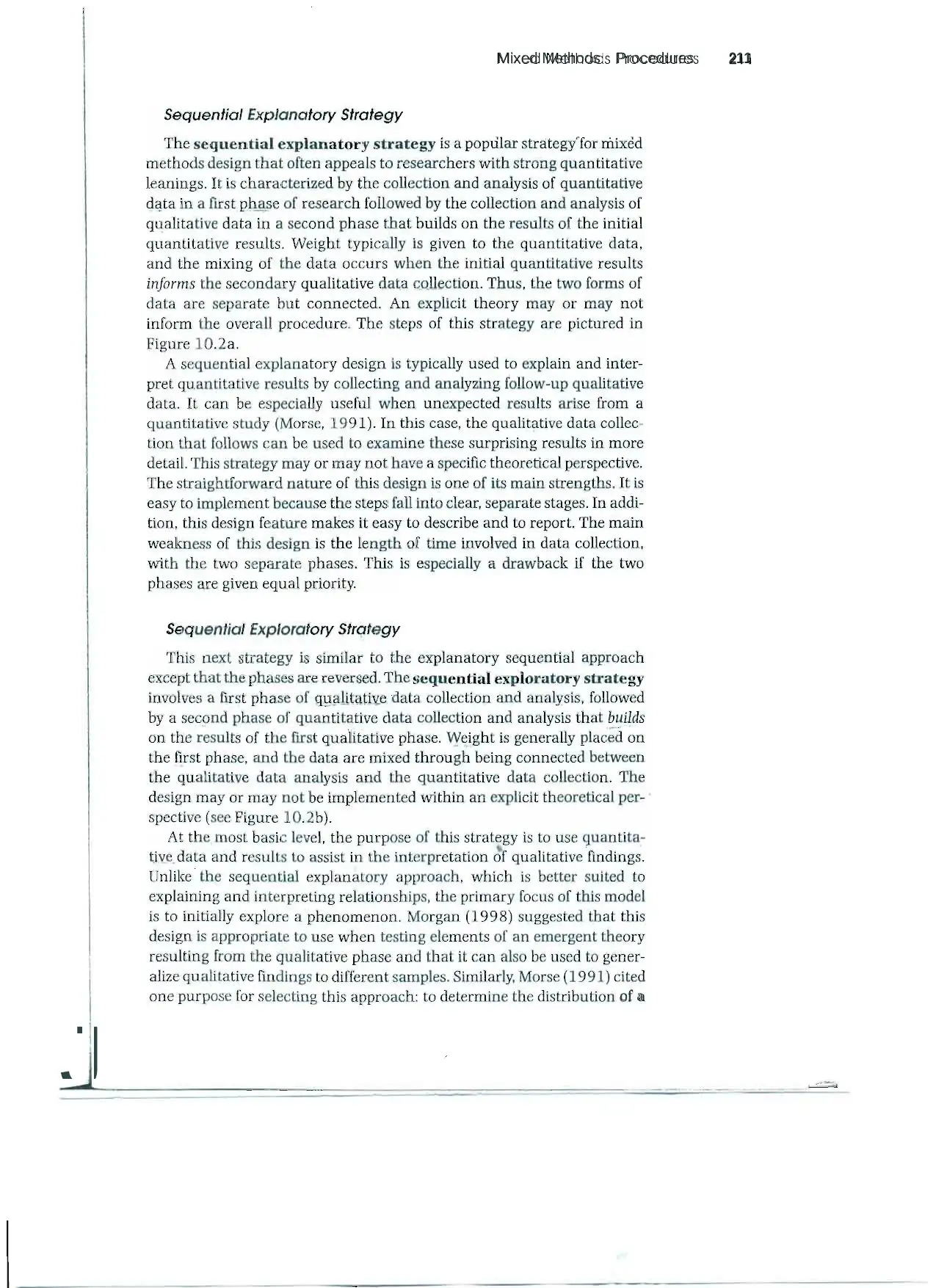
!
I
J
Mixed Methods Procedures 211
Sequenfial Explanafory Sfrafegy
The sequential explanatory strategy is a popular strategy for mixed
methods design that often appeals to researchers with strong quantitative
leanings. It is characterized by the collection and analysis of quantitative
data in a first ph--ª.seof research followed by the collection and analysis of
qualítative data in a second phase that builds on the results of the initial
quantitative results. Weight typically is given to the quantitative data.
and the mixing of the data occurs when the initial quantitative results
informs the secondary qualitative data collectíon. 'I'hus, the two forms of
data are separate but connected. An explicit theory may or may not
inform the overall procedure. The steps of this strategy are pictured in
Figure 10.2a.
A sequential explanatory design is typically used to explain and inter-
pret quantitative results by collecting and analyzing follow-up qualitative
data. It can be especially useful when unexpected results arise from a
quantitative study (Morse, 1991). In thís case. the qualitative data collec-
tion that follows can be used to examine these surprising results in more
detail. This strategy may or may not have a specific theoretical perspective.
The straightforward nature of this design is one of its main strengths. It is
easy to implement beca use the steps fall into clear, separate stages. In addi-
tíon, thís design feature makes it easy to describe and to report. The main
weakness of this design is the length of time involved in data collection.
with the two separate phases. Thís is especially a drawback if the two
phases are given equal priority.
Sequenfial Exploratory StrQfegy
Thís next strategy is similar to the explanatory sequential approach
except that the phases are reversed. The sequential exploratory strategy
involves a fírst phase of qg~mªtüLe data collection and analysis. followed
by a second phase of quantitative data collection and analysis that builds
on the results of the fírst qualítatíve phase. "Ye,.ightis generally placed on
the Arst phase, and the data are mixed through being connected between
the qualitative data analysis and the quantitative data collection. The
design may or may not be implemented within an explicit theoretical per- .
spective (see Figure 10.2b).
At the most basic Ievel, the purpose of this strategy is to use quantita-
U'le_ data and results to assist in the interpretation Jf qualitativefindings.
Unlike .the sequential explanatory approach. which is better suited to
explaining and interpreting relationships. the primary focus of thís model
is to initially explore a phenomenon. Morgan (1998) suggested that thís
design is appropriate to use when testing elements of an emergent theory
resulting from the qualitative phase and that it can also be used to gener-
alize qualitative findings to different samples. Símllarly; Morse (1991) cited
one purpose for selecting this approach: to determine the distribution of a
I
J
Mixed Methods Procedures 211
Sequenfial Explanafory Sfrafegy
The sequential explanatory strategy is a popular strategy for mixed
methods design that often appeals to researchers with strong quantitative
leanings. It is characterized by the collection and analysis of quantitative
data in a first ph--ª.seof research followed by the collection and analysis of
qualítative data in a second phase that builds on the results of the initial
quantitative results. Weight typically is given to the quantitative data.
and the mixing of the data occurs when the initial quantitative results
informs the secondary qualitative data collectíon. 'I'hus, the two forms of
data are separate but connected. An explicit theory may or may not
inform the overall procedure. The steps of this strategy are pictured in
Figure 10.2a.
A sequential explanatory design is typically used to explain and inter-
pret quantitative results by collecting and analyzing follow-up qualitative
data. It can be especially useful when unexpected results arise from a
quantitative study (Morse, 1991). In thís case. the qualitative data collec-
tion that follows can be used to examine these surprising results in more
detail. This strategy may or may not have a specific theoretical perspective.
The straightforward nature of this design is one of its main strengths. It is
easy to implement beca use the steps fall into clear, separate stages. In addi-
tíon, thís design feature makes it easy to describe and to report. The main
weakness of this design is the length of time involved in data collection.
with the two separate phases. Thís is especially a drawback if the two
phases are given equal priority.
Sequenfial Exploratory StrQfegy
Thís next strategy is similar to the explanatory sequential approach
except that the phases are reversed. The sequential exploratory strategy
involves a fírst phase of qg~mªtüLe data collection and analysis. followed
by a second phase of quantitative data collection and analysis that builds
on the results of the fírst qualítatíve phase. "Ye,.ightis generally placed on
the Arst phase, and the data are mixed through being connected between
the qualitative data analysis and the quantitative data collection. The
design may or may not be implemented within an explicit theoretical per- .
spective (see Figure 10.2b).
At the most basic Ievel, the purpose of this strategy is to use quantita-
U'le_ data and results to assist in the interpretation Jf qualitativefindings.
Unlike .the sequential explanatory approach. which is better suited to
explaining and interpreting relationships. the primary focus of thís model
is to initially explore a phenomenon. Morgan (1998) suggested that thís
design is appropriate to use when testing elements of an emergent theory
resulting from the qualitative phase and that it can also be used to gener-
alize qualitative findings to different samples. Símllarly; Morse (1991) cited
one purpose for selecting this approach: to determine the distribution of a
⊘ This is a preview!⊘
Do you want full access?
Subscribe today to unlock all pages.

Trusted by 1+ million students worldwide
1 out of 25
Related Documents
Your All-in-One AI-Powered Toolkit for Academic Success.
+13062052269
info@desklib.com
Available 24*7 on WhatsApp / Email
![[object Object]](/_next/static/media/star-bottom.7253800d.svg)
Unlock your academic potential
Copyright © 2020–2025 A2Z Services. All Rights Reserved. Developed and managed by ZUCOL.





